How to Teach Kids to Memorize Things Fast
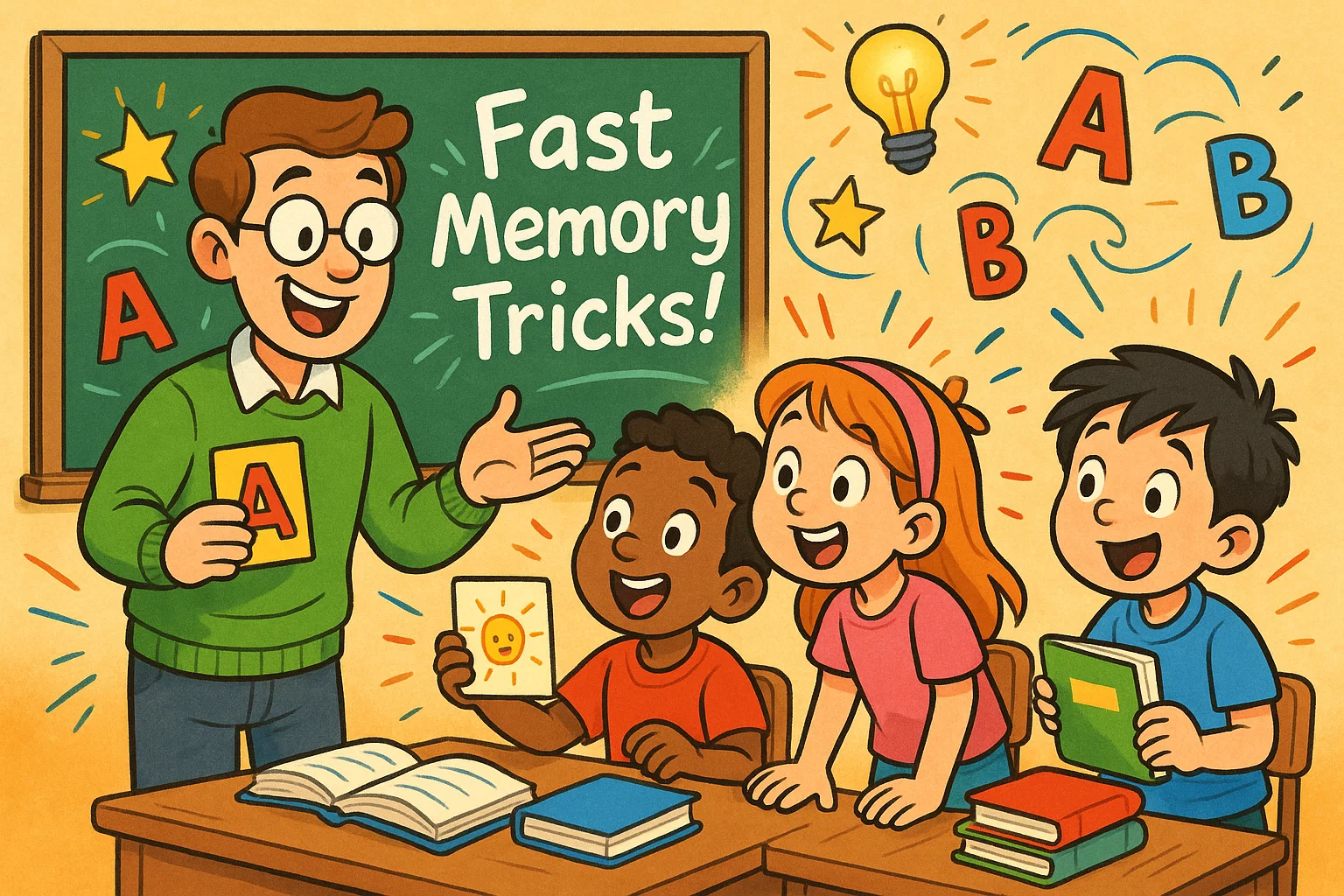
A child’s ability to memorize is a core building block for academic success. It’s not just about recalling facts—strong memory skills support focus, problem-solving, and confidence. When children learn to memorize efficiently, they free up mental space for deeper learning.
The good news is that memory can be strengthened through practice and the right techniques. This guide, grounded in child development and cognitive science, offers proven, engaging methods to help kids build lasting memory skills beyond simple repetition.
How Memory Works in Children
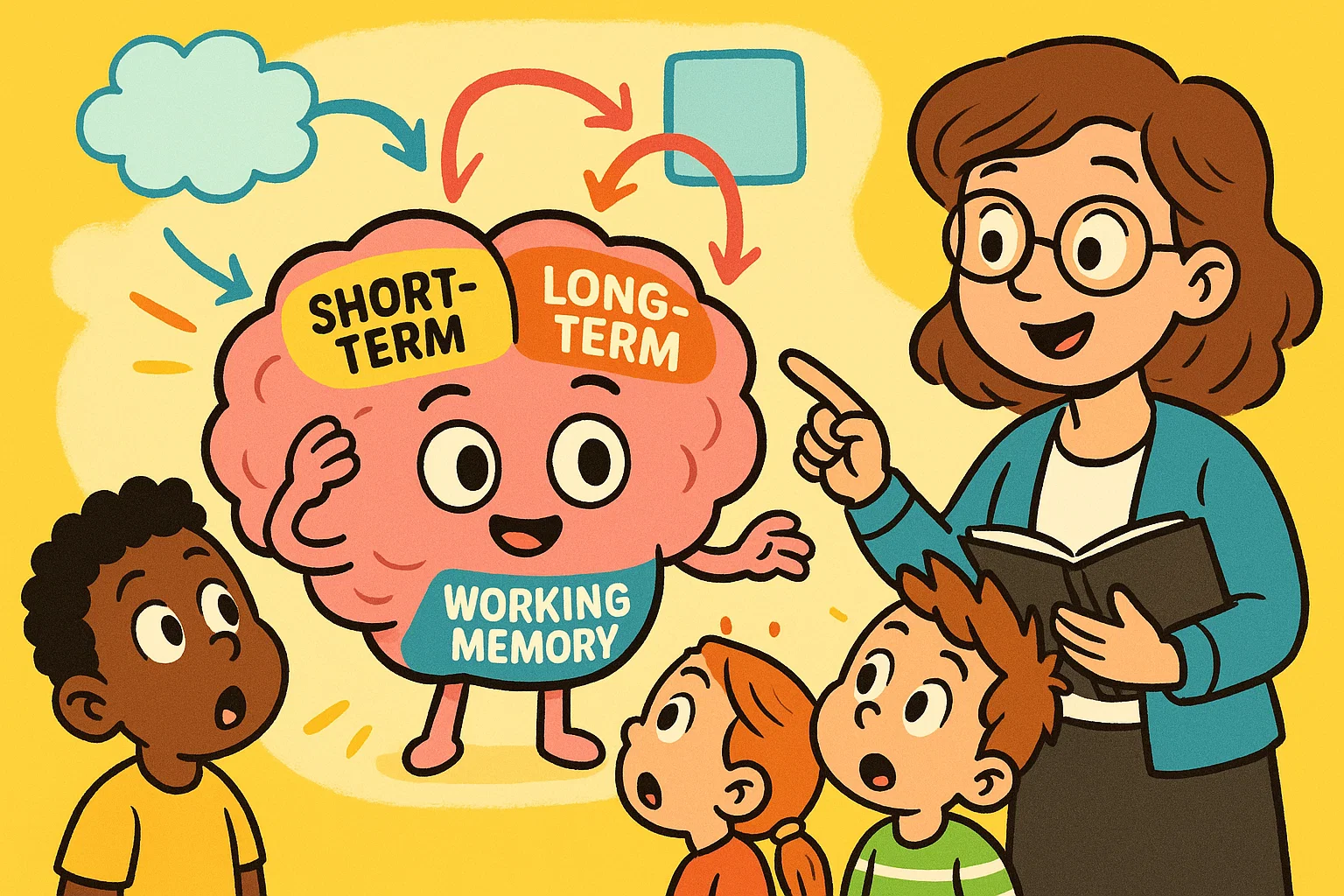
To effectively help your child memorize, it’s crucial first to understand the basics of how memory works. Think of a child’s mind as a bustling information hub with three main storage areas: short-term memory, working memory, and long-term memory.
- Short-Term Memory: This is a temporary holding space. It can only hold a small amount of information (like a new phone number) for a very brief period—usually less than 30 seconds—unless that information is actively rehearsed.
- Working Memory: This is the cognitive “desk” where conscious thought happens. It’s where we actively manipulate and use the information we are trying to memorize. For example, a child uses their working memory to follow multi-step directions or solve a simple math problem.
- Long-Term Memory: This is the brain’s permanent storage system, capable of holding vast amounts of information for a lifetime. The goal of any memorization technique is to successfully transfer information from the working memory into this long-term storage.
Role of Repetition and Recall
The primary way we get information from the short-term to the long-term memory is by strengthening the neural connections associated with that information. This is where active recall comes into play.
Simply reading or passively repeating something (passive memorization) creates a weak, easily forgotten memory trace. However, when a child is forced to actively retrieve or recall information from their mind without looking at the source, it powerfully reinforces the memory. This process, known as the ‘testing effect,’ shows that repeatedly recalling information is far more effective than simply rereading it.. This is why tools like flashcards and quizzes are so valuable—they force your child to recall information actively.
Stages of Memory Formation
The process of memory formation can be broken down into three key stages, which can be easily understood by relating them to a common experience like baking:
| Stage | What It Is | Kid-Friendly Example (Baking) | Memorize Application |
| 1. Encoding | Taking in and processing the information. The brain converts sensory input into a memorable “code.” | Reading the recipe and understanding the ingredients and steps. | Paying attention, associating the new information with something they already know, and visualizing it. |
| 2. Storage | Maintaining the encoded information in the brain over time. This is where memory consolidation happens, often during sleep. | Placing the mixed batter (the information) in the oven to solidify its form. | Using techniques like chunking or a mnemonic to create a strong, stable “storage file” for the new pieces of information. |
| 3. Retrieval | Accessing and bringing the stored information back into conscious awareness (i.e., recall). | Taking the finished, solidified cake out of the oven to serve it. | Answering a question on a test or explaining a concept to a friend. The easier the retrieval, the stronger the original memory. |
Common Memory Challenges in Kids
It’s completely normal for children to forget things. However, recognizing why they struggle to retain information can help you choose the right intervention:
- Distraction and Lack of Focus: A child cannot remember what they never properly paid attention to. A scattered mind prevents effective encoding.
- Overload: Trying to memorize information quickly (especially large amounts of information at once) overloads the working memory, leading to rapid forgetting.
- Lack of Context: Information learned in isolation is harder to remember. If a child doesn’t understand why they need to remember something, the brain assigns it low priority.
- Fatigue/Poor Sleep: Memory consolidation, the process of turning short-term memories into long-term memory, happens primarily during sleep. A tired child is a forgetful child.
Key Principles of Fast Memorization
Before introducing specific memorization techniques, it’s essential to build a foundation by teaching your child three key principles that make the brain more receptive to learning: focus, association, and visualization. These principles are universal accelerators for anyone who wants to memorize efficiently.
Focus and Attention
The first step in learning how to memorize is teaching your child to properly encode the information. If their attention is split, the memory trace will be weak.
- Establish a ‘Quiet Zone’: Designate a specific, clutter-free, distraction-free study space. This helps the brain shift into a focused learning mode.
- The Pomodoro Method (Kid-Friendly Edition): Use a timer for focused learning sessions (e.g., 10-15 minutes of intense focus) followed by short, fun breaks (e.g., 5 minutes of stretching or playing). This trains the attention span.
- Mindfulness Games: Simple exercises like focusing on one sound at a time or slowly building a block tower can improve sustained attention, which directly supports memory improvement.
Association and Connection
The human brain does not remember isolated facts well; it remembers connections. The principle of association is about linking new, unfamiliar information to something the child already knows. This makes the new information stickier and easier to recall.
- Relate to Real Life: If they are trying to remember a historical event, ask them to connect it to a recent family trip or a movie they’ve seen.
- Use Analogies: Help them create simple comparisons. For instance, saying that a cell’s nucleus is like the principal’s office—the control center—makes the concept easier to remember. This is crucial for learning and memorization.
Visualization and Imagination
Our brains are naturally wired for visual and spatial memory. Creating vivid, often silly, mental pictures is one of the most powerful ways to memorize anything. When you visualize an abstract concept, you engage the highly effective visual cortex.
- Make it Sensory: Encourage your child to not just see the mental picture, but to hear it, smell it, taste it, or feel it. The more senses involved, the stronger the memory.
- Action and Emotion: Mental images that involve action, movement, or strong emotion are much easier to recall information. If they want to remember the parts of a flower, have them imagine the pollen tickling their nose or the petals dancing in the wind.
Proven Techniques to Help Kids Memorize Fast
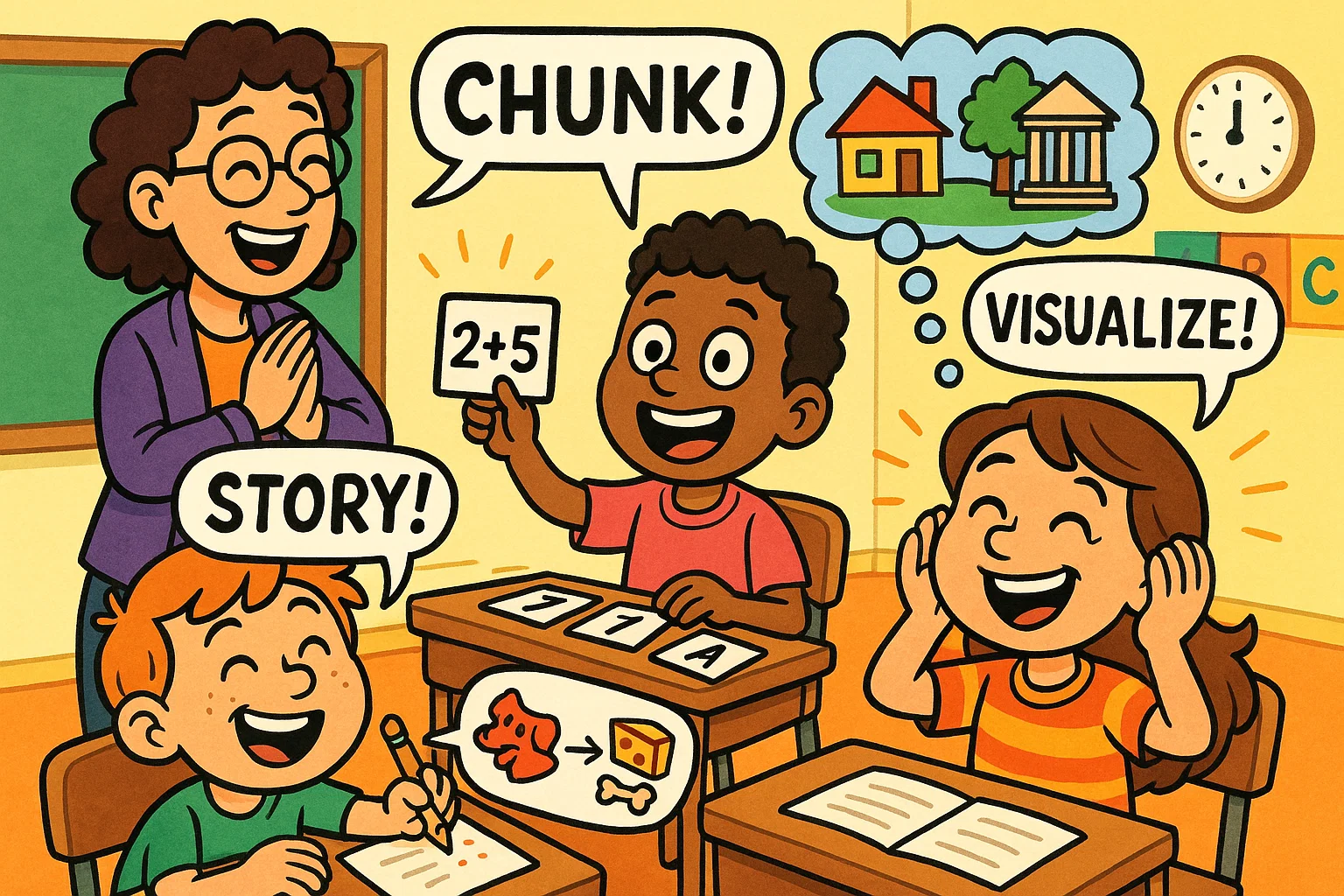
The following are evidence-based memorization methods that tap into the brain’s natural way of learning how to learn. These are the best memorization techniques to help students turn difficult subjects into manageable tasks.
Chunking Method
Chunking means breaking large amounts of information into smaller, meaningful groups. This is vital because the working memory can only hold about 4-7 items at a time. By grouping items, you effectively reduce the number of items your child has to process.
Examples:
- Phone Numbers: 123-456-7890 is easier to remember than 1234567890.
- Spelling Words: Break a complex word like “memorization” into syllables: mem-o-ri-za-tion.
- Historical Dates: Group events by century or theme rather than as a random list.
Story Method
The human brain loves narratives. The story method involves turning a dry list of facts into a fun, engaging, and memorable story. This leverages the power of association and visualization simultaneously.
- How to Do It: If your child needs to memorize a series of unrelated facts (e.g., a grocery list of milk, bread, eggs, and cheese), they might imagine a story: “The milk spilled all over the bread, so the baker took the eggs and threw them at the angry customer who was wearing a bright yellow cheese hat.” The sillier and more action-packed the story, the better.
Acronyms and Rhymes
Mnemonic devices are tools that give the brain an easy ‘hook’ to hang complex information on. They are one of the fastest ways to memorize things.
- Acronyms: Creating a new, pronounceable word using the first letter of each word you need to remember. For example, to remember the Great Lakes, kids can use the acronym HOMES (Huron, Ontario, Michigan, Erie, Superior).
- Acrostics: Creating a sentence where the first letter of each word is a cue for the information. For example, to remember the order of operations in math, they can use, “Please Excuse My Dear Aunt Sally.”
- Rhymes: Using a rhyme to help remember short facts. “Thirty days hath September, April, June, and November…” Rhyme and rhythm are powerful aids for fast memorization.
Memory Palace Technique
The Memory Palace (also known as the Method of Loci) is one of the most powerful techniques to help people memorize information better, and it can be simplified for children. It leverages the brain’s incredible spatial memory.
How to Build a Palace:
- Create a mental walk-through of a very familiar location, such as their bedroom, the school hallway, or the walk from the car to the house. This familiar route is their palace.
- Identify specific “spots” or loci along the route (e.g., the doorknob, the bed, the desk, the window).
- Take the pieces of information they want to memorize and visualize them as vivid, often bizarre, objects interacting with each of those spots.
- Example: If they need to remember vocabulary words, they can place a funny image of the word frugal acting stingy on their doorknob, and an image of ephemeral disappearing at their desk. When they try to memorize it, they simply walk through their palace and recall the silly scene at each location. Using the memory palace technique turns rote learning into a fun, imaginative game.
Peg and Link Method
This technique involves associating numbers with rhyming words (pegs) and then linking the facts to those rhyming pegs.
| Number | Peg Word (Rhyme) |
| 1 | Sun |
| 2 | Shoe |
| 3 | Tree |
| 4 | Door |
Example: If they need to recall the four stages of the water cycle:
- 1 (Sun): Evaporation – They imagine the sun heating the water up until it evaporates.
- 2 (Shoe): Condensation – They see a cloud condensing inside their shoe.
- 3 (Tree): Precipitation – They see rain (precipitation) falling all over a tree.
Flashcards and Active Recall
Flashcards are classic for a reason, but they must be used for active recall.
- Parent-Assisted Rotation: Have the child go through the stack, setting aside the cards they got right. The cards they struggled with are reviewed more frequently. This is an early form of spaced repetition.
- Two-Way Cards: Instead of just a question on one side and an answer on the other, use flashcards that test for different types of recall. For example, a card could have the term “Mnemonic” on one side and ask, “Give an example of a mnemonic technique” on the other.
Mind Maps
For visual learners, mind maps are a powerful memory technique that turns a linear, overwhelming amount of notes into an organized, radial structure.
- How to Use: Place the main concept (e.g., “The Solar System”) in the center of the page. Then, draw branches for key sub-topics (e.g., “Planets,” “Stars,” “Moons”). Finally, draw smaller branches off the sub-topics for specific facts. Drawing connections between ideas makes the information easier to remember because it mimics how the brain naturally stores related thoughts.
Fun Activities to Strengthen Memory
The best ways to boost memory in children often don’t feel like studying at all. Integrating playful, sensory, and highly engaging activities is an effective memorization approach.
Music and Rhythm Games
Music stimulates multiple parts of the brain simultaneously, making it an excellent vehicle for learning and memorization.
- Singing the Facts: Turn vocabulary lists or historical dates into simple songs. Even a simple, familiar tune (like “Twinkle Twinkle Little Star”) can be adapted. Singing the multiplication tables or the alphabet are classic examples that help information stick.
- Clapping Rhythms: Create a rhythm for a list of words or concepts. Clapping, tapping, or marching while saying the information adds a kinesthetic component that reinforces the memory trace.
Multi-Sensory Learning
The more senses a child engages, the more mental pathways they create for retrieval, making the ability to recall stronger.
- Kinesthetic/Tactile: Allow children to write out vocabulary words in sand, shape playdough into the letters, or use colored pens to highlight important concepts. Movement breaks during study sessions refresh the mind.
- Auditory: Have your child read their notes aloud (not just in their head), or record themselves explaining a concept and listen back to it.
Educational Games and Challenges
Turning study into a game lowers the stress level and makes children want to remember.
- “Memory Match”: A classic game that directly trains short-term memory and focus.
- “Tell Me the Story”: After reading a chapter, challenge your child to a competition to see who can retell the most detailed, sequential, and accurate summary of the story.
- “Reverse Quiz”: Have your child take the role of the teacher and create a quiz for you. This forces them to critically review the material and is an excellent way to strengthen memory.
Teaching Others
One of the most powerful learning strategies is the “learn by teaching” method. When a student has to explain a new concept clearly to a younger sibling, a parent, or even a toy, they are forced to organize the information, identify any gaps in their own understanding, and retrieve the information multiple times.
- The Feynman Technique: Ask your child to teach you a topic they just learned using simple language. If they can’t explain it simply, they don’t fully understand or have not effectively stored the information better.
Everyday Habits that Boost Memory
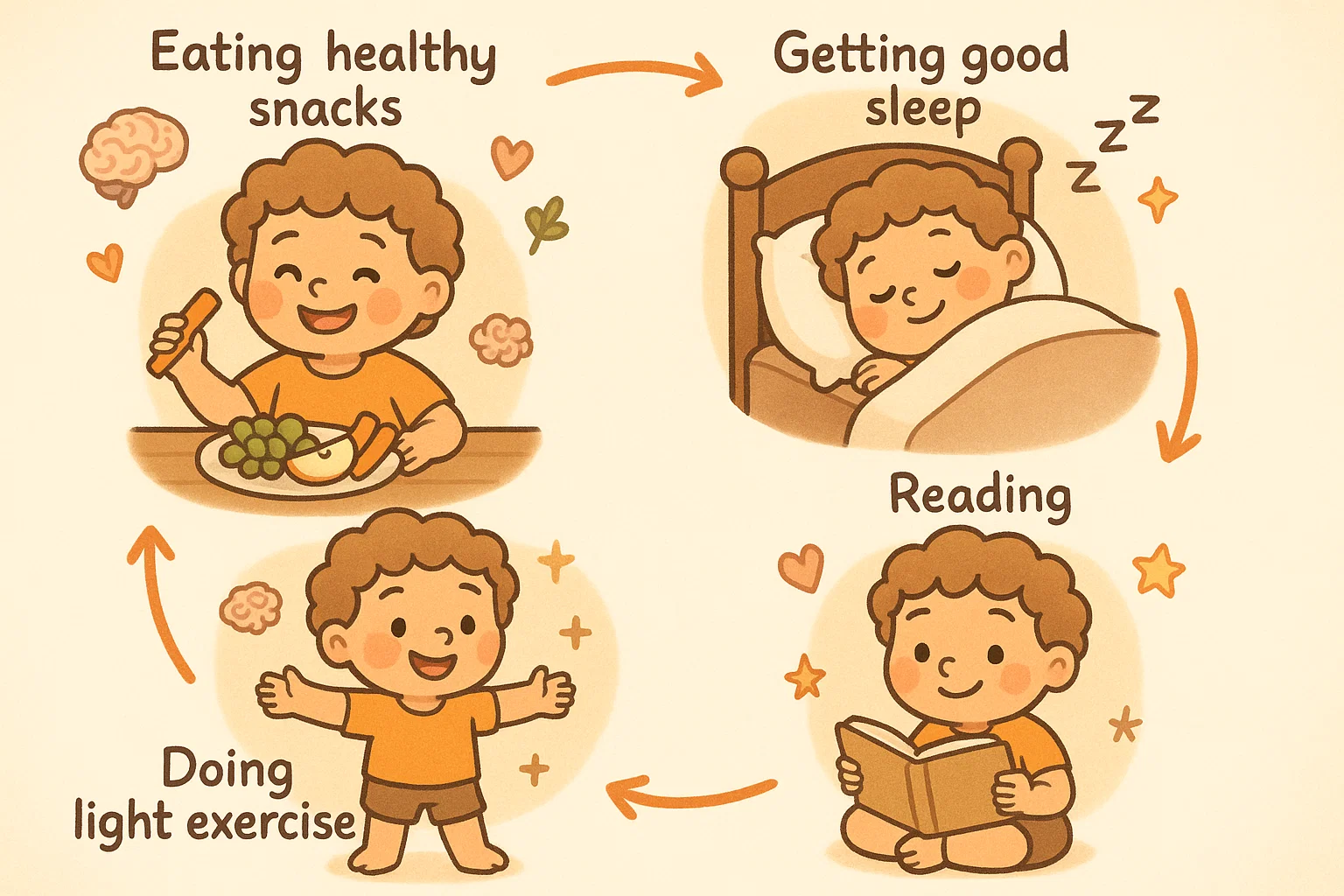
Memory improvement isn’t solely about techniques; it’s about optimizing the brain’s environment. These daily habits are foundational to a strong ability to memorize and recall.
Sleep and Rest
Sleep is not just rest—it’s a critical period for memory consolidation. During deep sleep, the brain rehearses and solidifies memories formed during the day, transferring them into long-term storage.
- The Rule of 9-11: Most school-age children need between 9 and 11 hours of sleep per night. Irregular or insufficient sleep can severely impact a child’s working memory and attention span.
- Quiet Time Before Bed: Avoid screens at least 30 minutes before sleep, as the blue light interferes with the release of melatonin, the sleep hormone.
Nutrition for Brain Health
A well-fed brain is a better-functioning brain. Certain nutrients support the structure and function of brain cells.
| Food Group | Key Benefit for Memory | Examples to Encourage |
| Omega-3 Fatty Acids | Essential for building brain and nerve cells. | Salmon, walnuts, flax seeds, chia seeds. |
| Antioxidants | Protect brain cells from damage. | Blueberries, strawberries, and raspberries—great for boosting focus. |
| Complex Carbohydrates | Provide a steady supply of glucose (brain fuel). | Whole grains, oats, brown rice. |
| Hydration | Water is essential for all brain function. | Consistent access to water throughout the day. |
Movement and Physical Activity
Physical activity increases blood flow to the brain, which in turn delivers more oxygen and nutrients. Exercise also stimulates the release of brain-derived neurotrophic factor (BDNF), a protein that supports the growth of new neurons and strengthens memory circuits. Even 20 minutes of moderate activity can boost focus and memory skills.
Limiting Distractions
Creating a focus-friendly environment means minimizing the noise and interruptions that compete with the child’s working memory.
- Digital Detox: Implement “no-screen” times during homework or concentrated play. Constant alerts from devices pull focus away and block the deep processing needed for memorization.
- Clear the Desk: A visually overwhelming workspace is an easily distracting one. Keep only the necessary materials out.
Common Mistakes Parents Make When Teaching Memorization
Even with the best intentions, parents can inadvertently use methods that hinder a child’s natural learning and memorization process.
Overloading Information
A major pitfall is forcing a child to memorize everything right before a test (cramming). This overloads the short-term memory, often leading to a phenomenon known as “massed practice,” where the information is quickly forgotten after the test.
- Solution: Introduce the need to memorize material in small, digestible “chunks” well in advance of the deadline.
Passive Memorization
Parents often encourage children to simply read their notes over and over again, or verbally repeat a fact ten times. This gives the illusion of learning but is not an effective way to memorize.
- Solution: Prioritize active recall methods. Instead of saying, “Read your history notes five times,” say, “Read the notes once, then close your book and try to write down everything you can remember.”
Ignoring Learning Styles
Assuming every child learns best by reading, or that what worked for the parent will work for the child, ignores the unique way each person processes information.
- Visual Learners: Need to see diagrams, mind maps, and flashcards. They excel using the memory palace.
- Auditory Learners: Learn by hearing, discussing, and creating rhymes or songs.
- Kinesthetic Learners: Learn by doing, moving, and using hands-on activities like building models or writing on a whiteboard. Tailoring the approach is key to helping information stick.
Building Long-Term Memory Skills
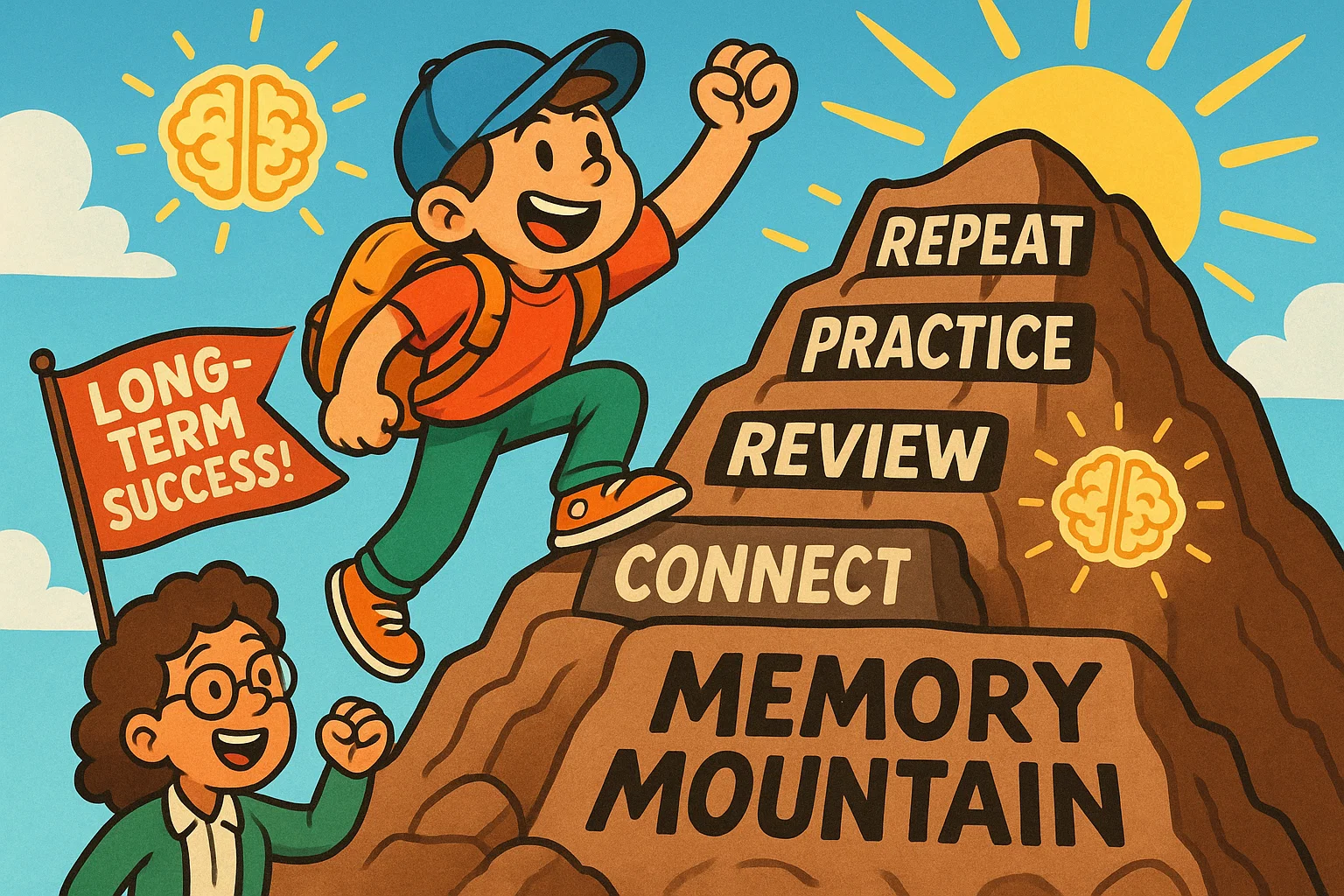
The ultimate goal is not just short-term recall but creating a framework that allows the child to retain information indefinitely. This requires a systematic approach to review.
Spaced Repetition Done Right
Spaced repetition is a critical memorization strategy where review sessions are scheduled over increasing intervals of time to prevent forgetting. It works because the brain makes the most effort to retrieve information right when it’s about to forget it, which dramatically strengthens the memory trace.
A Simple Schedule:
- Day 1: Learn the new concept/words.
- Day 2: First review.
- Day 4: Second review.
- Day 8: Third review.
- Day 16: Fourth review.
- This is far more effective than reviewing five times in a row on Day 1. It helps transfer knowledge into long-term memory.
Review Loops and Reflection
Encourage short, high-quality review periods rather than long, draining ones.
- The 5-Minute Review: At the end of every school day, have your child spend just five minutes reviewing what they learned in class. This short review loop greatly improves initial retention.
- Journaling/Reflection: Have the child write down (or verbally reflect on) the three most important things they learned that day. This active retrieval solidifies the memory.
Connecting Learning Across Subjects
Help your child see the world as an interconnected web, not as a collection of isolated school subjects.
- Example: When studying the geography of ancient Egypt (social studies), talk about the geometry used to build the pyramids (math) and the materials they used (science). Linking different pieces of information creates multiple memory pathways.
Inspiring Kids to Enjoy Memorization
Learning to memorize things shouldn’t be a chore; it should be an adventure. Motivation and a positive mindset are what truly make fast memorization possible.
Setting Small Goals and Rewards
Celebrate effort and incremental progress, not just the final result.
- Process Praise: Instead of saying, “You got an A, you’re so smart,” say, “You want to memorize this, and I noticed you used the chunking technique, and it really helped! Your effort paid off.”
- Non-Material Rewards: Offer things like extra reading time, a special trip to the park, or choosing the family movie as rewards for achieving small study milestones.
Using Real-World Examples
Show your child that memory skills are the source of amazing feats.
- Share Stories of Memory Heroes: Discuss people who use memory palace or mnemonic techniques—such as competitive memorizers or famous polyglots. This can inspire curiosity and confidence in memorizing complex information.
- Fun Trivia: Use quizzes and trivia games to show off their stored knowledge, emphasizing how fun it is to be able to recall information on demand.
Family Participation
Make memory games part of your regular family routine.
- “I Went to the Market” Game: A classic chain-memory game that trains verbal recall.
- Collaborative Mind Maps: Draw a mind map as a family on a large poster board about a vacation or a recent family event. This shows the practical application of the technique to memorize and remember things.
When Kids Struggle to Memorize
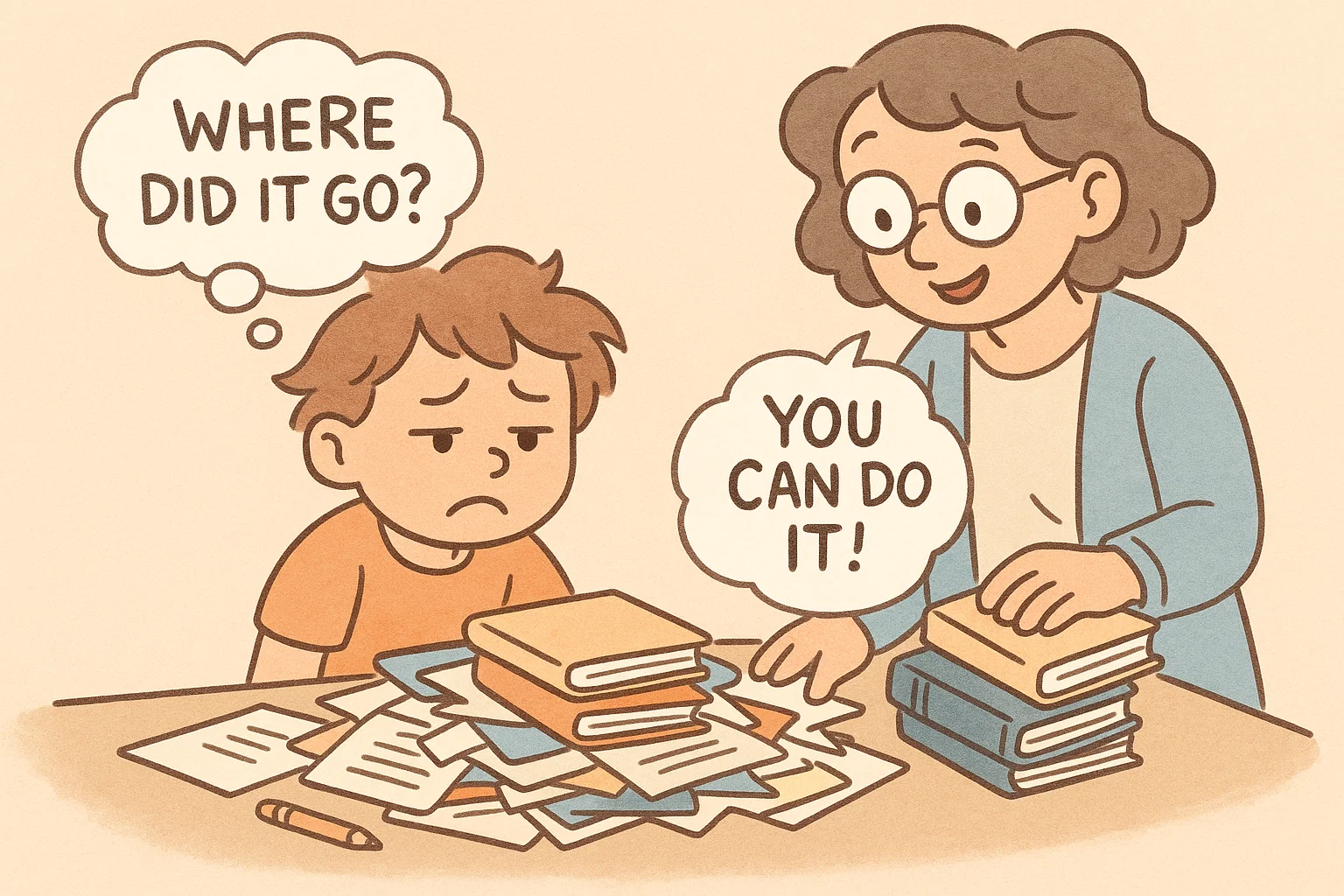
It’s important to differentiate between normal learning difficulties and more persistent challenges. Patience and consistency are key, but so is knowing when to seek additional support.
Signs of Memory Issues
Most children will occasionally struggle to remember information. However, persistent difficulties may suggest that a more targeted intervention is needed.
- Difficulty Following Multi-Step Directions: Especially if they understand the individual steps but struggle to remember the sequence.
- Trouble Retaining Simple Facts: Constantly forgetting simple information, even after multiple reviews (suggesting weak long-term memory encoding).
- Inability to Copy Notes Accurately: This often points to challenges with working memory (holding the information while writing it down).
When to Seek Professional Advice
If you notice that challenges are significantly impacting their schooling and self-esteem despite consistent use of evidence-based memorization methods, consider a consultation.
- Consult Teachers: Their teacher is the first resource for observations on how your child performs in the classroom setting.
- Pediatric or Specialist Consult: Persistent issues with attention and working memory may indicate conditions like ADHD or specific learning disabilities. Early identification is crucial for tailored support.
Patience and Consistency
Remember that building a strong memory is a marathon, not a sprint. The brain literally takes time to build the neural pathways required to efficiently memorize something.
- Encouragement Over Pressure: Maintain a positive, low-stress learning environment. Stress releases cortisol, which actively interferes with memory and learning.
- Techniques like spaced repetition will eventually work, but they require a consistent schedule. Don’t give up after a few tries; celebrate the small victories and focus on the effort your child puts into their memorization process.
Conclusion: How to Teach Kids Memorize Things Fast Effectively
The most powerful takeaway for parents and educators is that memory is a skill, and every child has the ability to recall and memorize information quickly with the right tools. Moving past outdated rote repetition and embracing active, creative techniques—such as chunking, the memory palace, and acronyms—is the path to success.
The fundamental principles are simple: Focus on the material, associate it with what you already know, and visualize it in vivid, silly ways. By fostering good habits—like proper sleep, nutrition, and regular activity—and maintaining a low-stress environment, you equip your child with the foundation for lifelong learning. The goal isn’t just to help them memorize quickly but to teach them how to learn effectively, building a robust long-term memory that will serve them in every endeavor.
